The September 11, 2001 attacks on the Twin Towers in New York City, during which 2,977 innocent people lost their lives and another 6,400 were injured, changed the face of history and resulted in events from which we still suffer consequences today. In addition, on the art side, the bombing caused a substantial loss to art heritage, with damage estimated at about $110 million (£68 million), according to the October 5, 2001 BBC News report, between Manhattan and the Pentagon. In fact, most of the works involved belonged to private collections, while a smaller portion, about $10 million, involved public works. Much of these works were not insured for their true value, amplifying the impact of the event on the entire industry. AXA Art experts described the attacks as the most serious catastrophe ever in the art industry, pointing out that it would be the largest set of claims for a single event. At the time, it was not yet clear how many works had been permanently lost, but $20 million (£13.5 million) was set aside for art-related claims. The total losses, in any case, could have been much higher once damage to works in surrounding buildings was included.
Indeed, inside the World Trade Center, the Port Authority of New York and New Jersey housed about one hundred works, to which were added seven public works designed specifically for the complex. The destruction of the Towers thus entailed the total loss or serious damage of all these works. Also according to the BBC Newspaperarticle publishedin 2001, Cantor Fitzgerald’s offices housed some 300 Rodin sculptures, which were also annihilated. At the Pentagon, on the other hand, 24 works were completely destroyed and another 40 suffered major damage. None of these works were covered by insurance, making a concrete economic assessment impossible. The public works affected and destroyed in New York included seven major works symbolizing the cultural and artistic impact of the attack, here are what they are.
Joan Miró (Barcelona, 1893 - Palma de Mallorca, 1983), together with master tapestry artist Josep Royo, created the World Trade Center Tapestry, completed in 1973 and initially exhibited at the Grand Palais in Paris. The following year it was moved to New York and placed in the South Tower, where it remained until its destruction on September 11, 2001. The idea of involving Miró in the project came from Saul Wenegrat, director of the Port Authority’s art program, but the artist declined because he wanted to deal with the work himself even though he did not know the tapestry technique.
The turning point came after a personal event: the recovery of his daughter, a victim of an accident in Spain. As a token of gratitude, Miró wanted to donate a tapestry to the hospital that had treated her and relied on Royo, beginning a collaboration that was destined to produce significant works, including the tapestry for the National Gallery of Art in Washington and the one for the Fundació Joan Miró. The New York work, woven in wool and hemp, measured about 6.1 × 10.7 meters and weighed 4 tons. It featured large red, green, blue and yellow backgrounds, interrupted by black shapes, on a light brown background.
Bent Propeller, also known as World Trade Center Stable, was a large stainless steel sculpture painted red, created by Alexander Calder (Lawnton, 1898 - New York, 1976). The work consisted of three large curved plates, joined together in such a way that they supported themselves solely by their own weight. In fact, the shape recalled a ship’s propeller and echoed the typical language of the artist’s public sculptures, often characterized by their bright red color.
Approximately 7.6 meters tall, the sculpture was initially placed next to the entrance of the North Tower (1 World Trade Center), before being relocated in 1970 to the plaza in front of 7 World Trade Center, at the northeast corner of Austin J. Tobin Plaza, between Vesey Street and Church Street. The work had been commissioned the previous year by the Port Authority of New York and New Jersey. On September 11, 2001, the work was swept away by the collapse of 7 World Trade Center and was crushed under thousands of tons of debris. In the months that followed, only about 40 percent of the structure could be salvaged, an insufficient amount to attempt reconstruction. The surviving fragments were then kept by the Calder Foundation, while today, part of the sculpture is on display at the National September 11 Memorial & Museum.
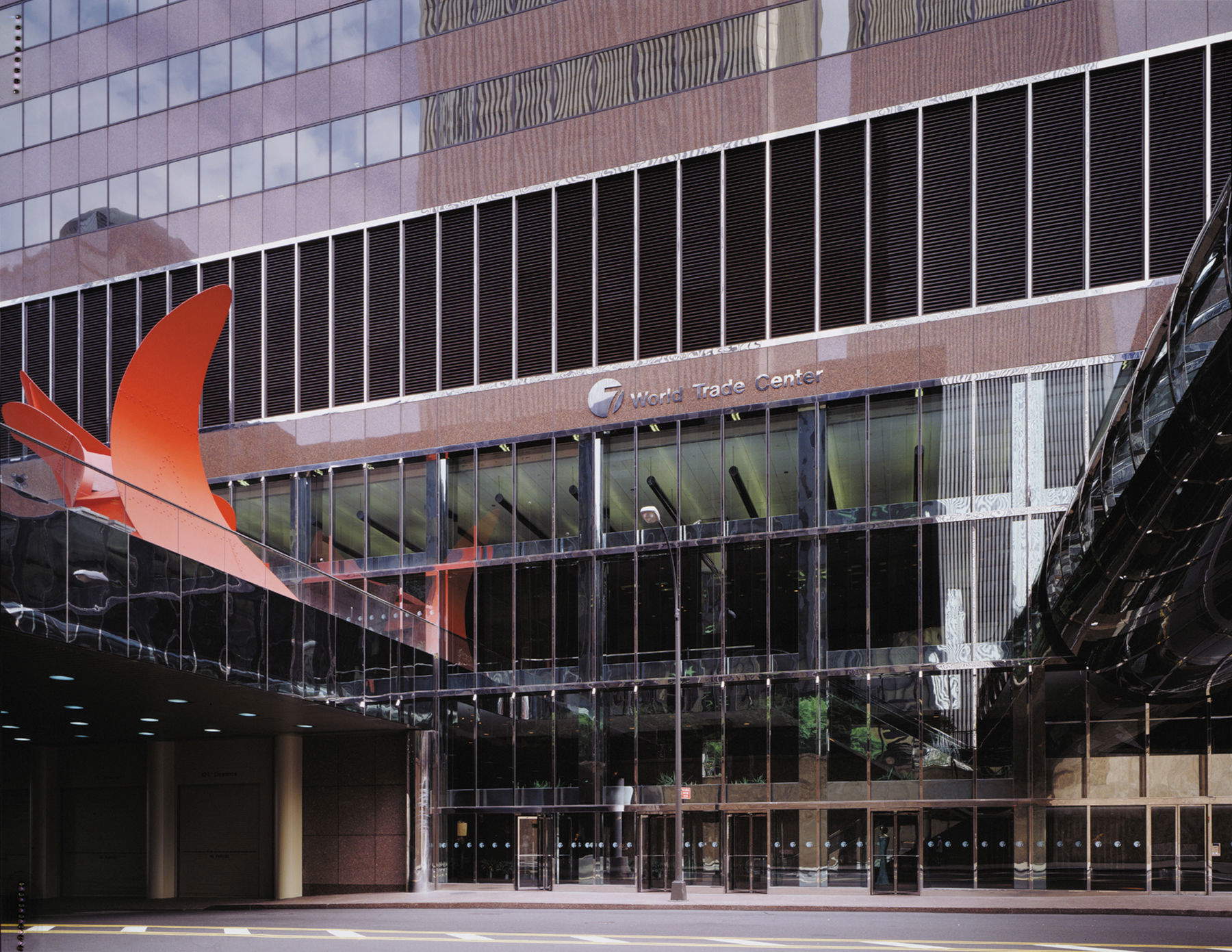
The Sphere, officially Große Kugelkaryatide N.Y., is a monumental bronze sculpture by Fritz Koenig (Würzburg - Bavaria, 1924 - Landshut, Bavaria, 2017). Standing 7.6 meters tall, over 5 meters in diameter and weighing more than 20 tons, it was called his eldest son by the artist. Made between 1968 and 1971 with the help of Hugo Jahn and Josef Plankensteiner, it was cast in 67 segments in Munich and assembled in Koenig’s studio, then shipped to New York. Commissioned by architect Minoru Yamasaki, designer of the World Trade Center, it was placed in 1971 in Austin J. Tobin Plaza between the Twin Towers.
Placed on a porphyry disk, the sculpture rotated, completing one revolution every 15 minutes as water from the Plaza Fountain flowed around it, giving the illusion of a sphere emerging from the basin. A symbol of peace through commerce, it became a meeting point and social hub of the complex. After September 11, 2001, it re-emerged damaged but almost intact from the rubble, and was the only surviving work of art from the catastrophe. Displayed in Battery Park since 2002, in 2017 it was moved to Liberty Park, next to the National September 11 Memorial, where it remains today in the condition in which it was found, transformed into a memorial to the victims.
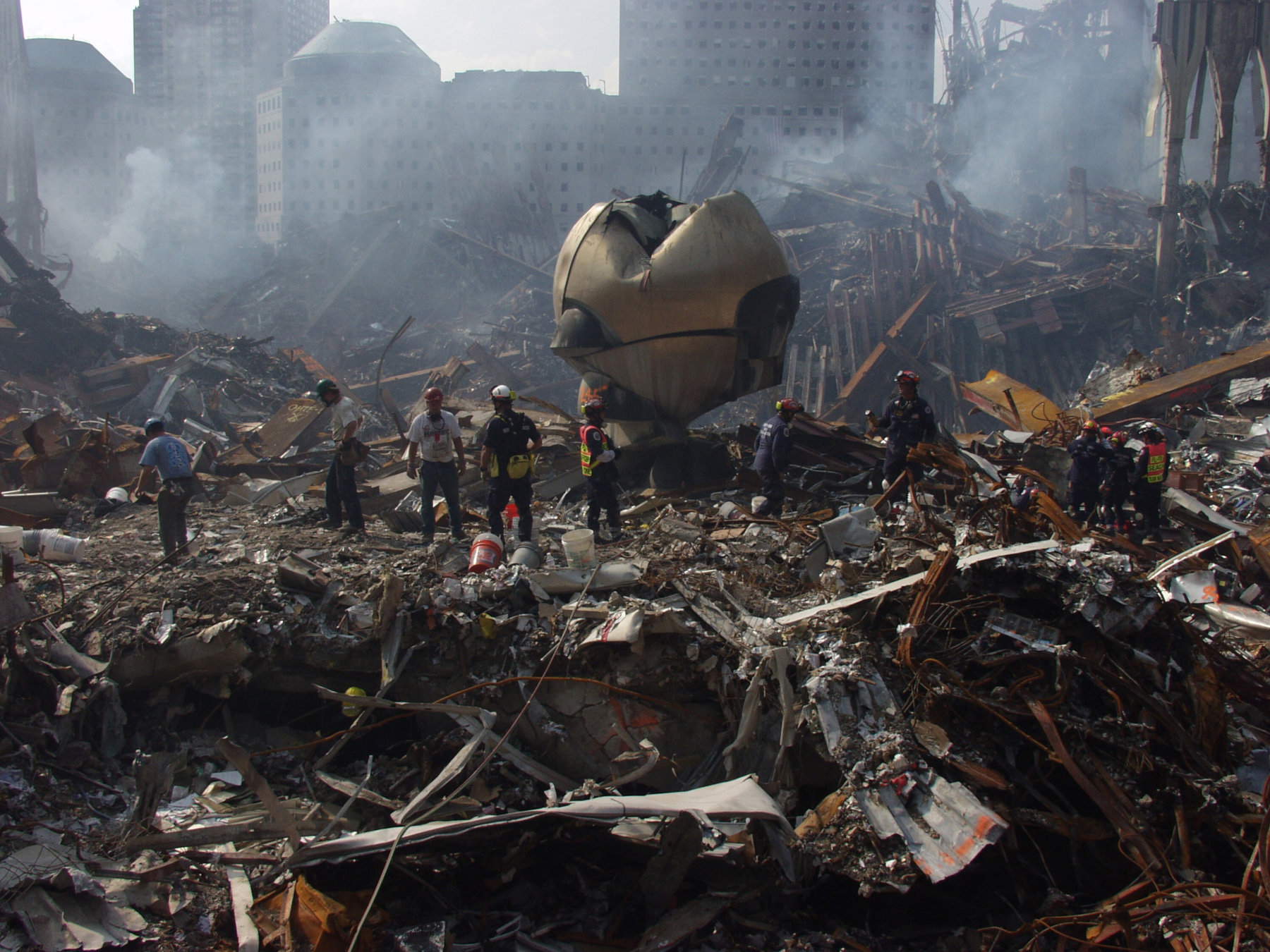
Ideogram represented one of the most iconic installations at the World Trade Center, a stainless steel work by American sculptor James Rosati (Washington, 1912 - New York, 1988) completed in 1972. The composition consisted of a network of interwoven beams whose reflective surfaces captured and refracted light, creating a dynamic dialogue with the surrounding space. The work had been commissioned in 1969 by the Port Authority Art Committee and subjected to wind tunnel experimentation before final installation in the plaza between the Twin Towers.
Placed in the Austin J. Tobin Plaza in front of the Marriott World Trade Center, the sculpture became an integral part of the cityscape, attracting the attention of visitors and photographers. On September 11, 2001, the work disappeared in the rubble produced by the collapse of the buildings. In fact, unlike Fritz Koenig’s bronze sphere, Ideogram ’s steel was completely mixed with the debris and no fragments could be recovered; the remains were removed along with the rest of the materials. According to Saul Wenegrat, former director of the Port Authority’s art program, the sculpture was probably the most photographed work in the entire complex and appeared frequently in advertisements and fashion shoots, a distinctive symbol of the World Trade Center.
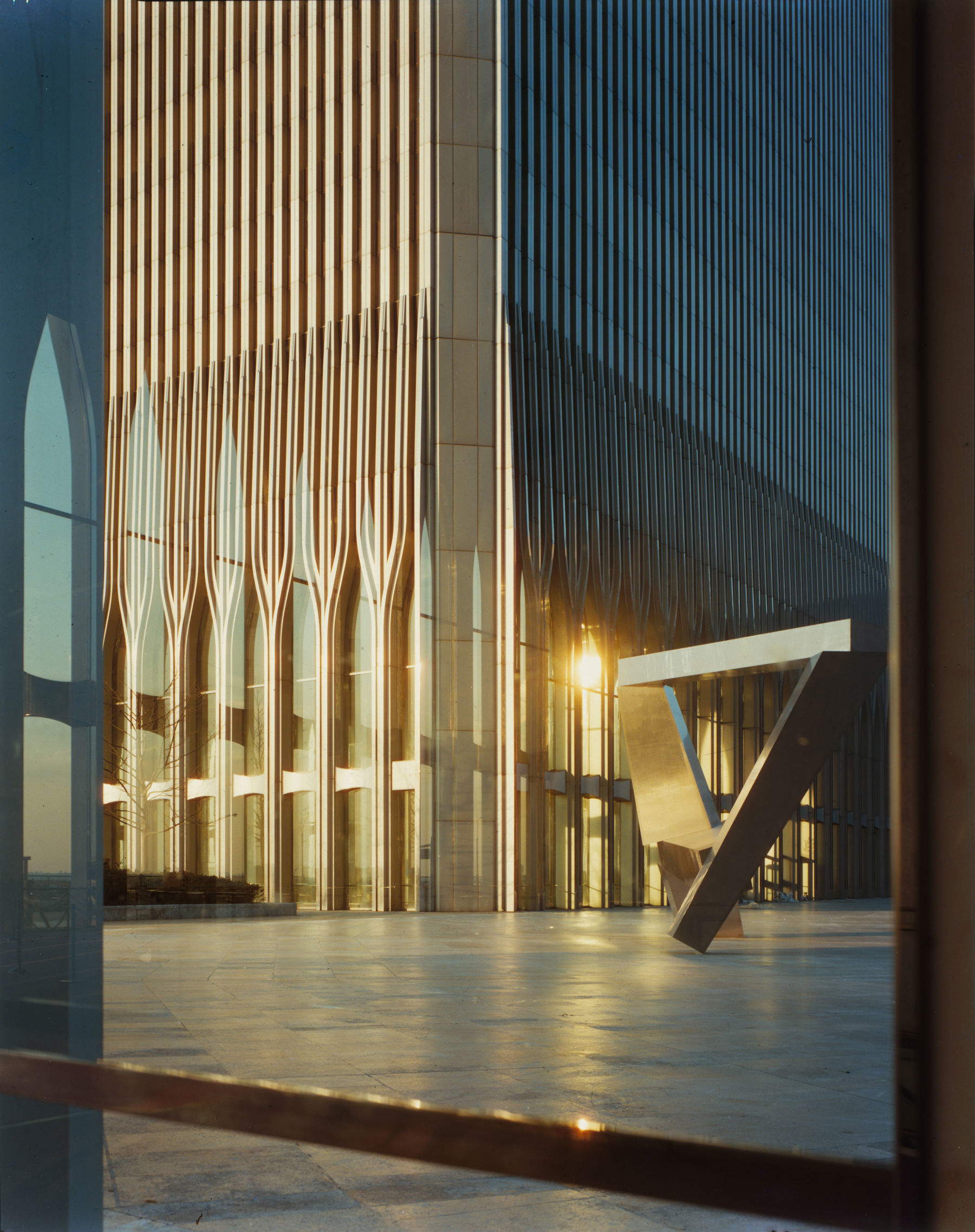
Cloud Fortress, a 1975 sculpture by Japanese artist Masayuki Nagare (Nagasaki, 1923 - 2018), stood at the Church Street entrance in the Austin J. Tobin Plaza of the World Trade Center. 4.3 meters high, 10 meters wide and 5.2 meters deep, it represented two pyramids joined at the base and tilted upward, creating an abstract and monumental form. Despite its massive appearance, it consisted of steel and concrete framework covered with black Swedish granite. Nagare employed the technique of ware hada (broken weave), alternating smooth and rough surfaces for a contrasting visual effect.
Part of the Port Authority’s art program, which allocated up to 1 percent of construction costs to artwork, the work was placed between Buildings 4 and 5 as a secondary entrance to the main plaza, blending harmoniously into the complex. Although it initially withstood the September 11, 2001 attacks and the collapse of nearby buildings, the sculpture was demolished in the following days to allow for emergency operations at Ground Zero. The debris was removed along with other rubble from the site.
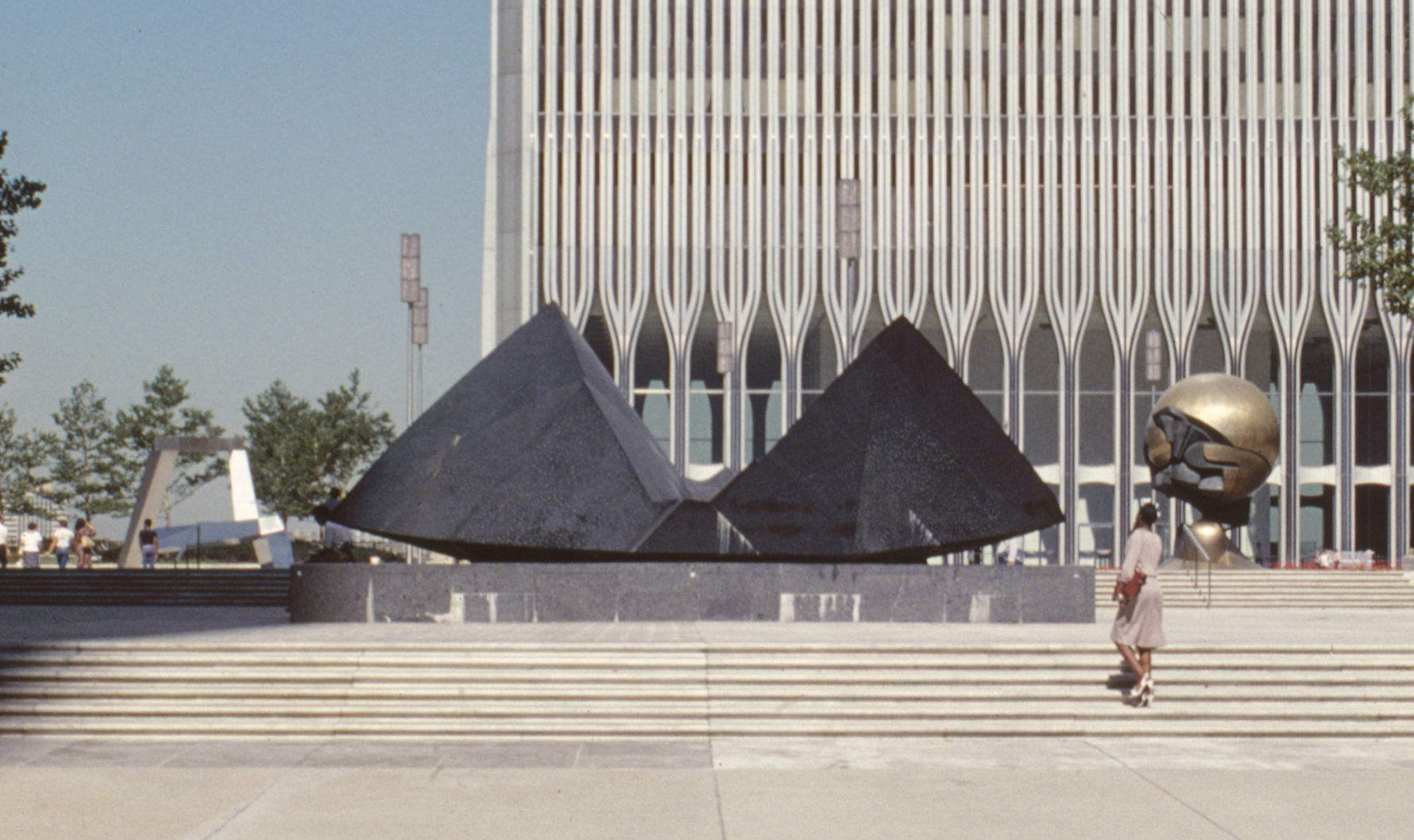
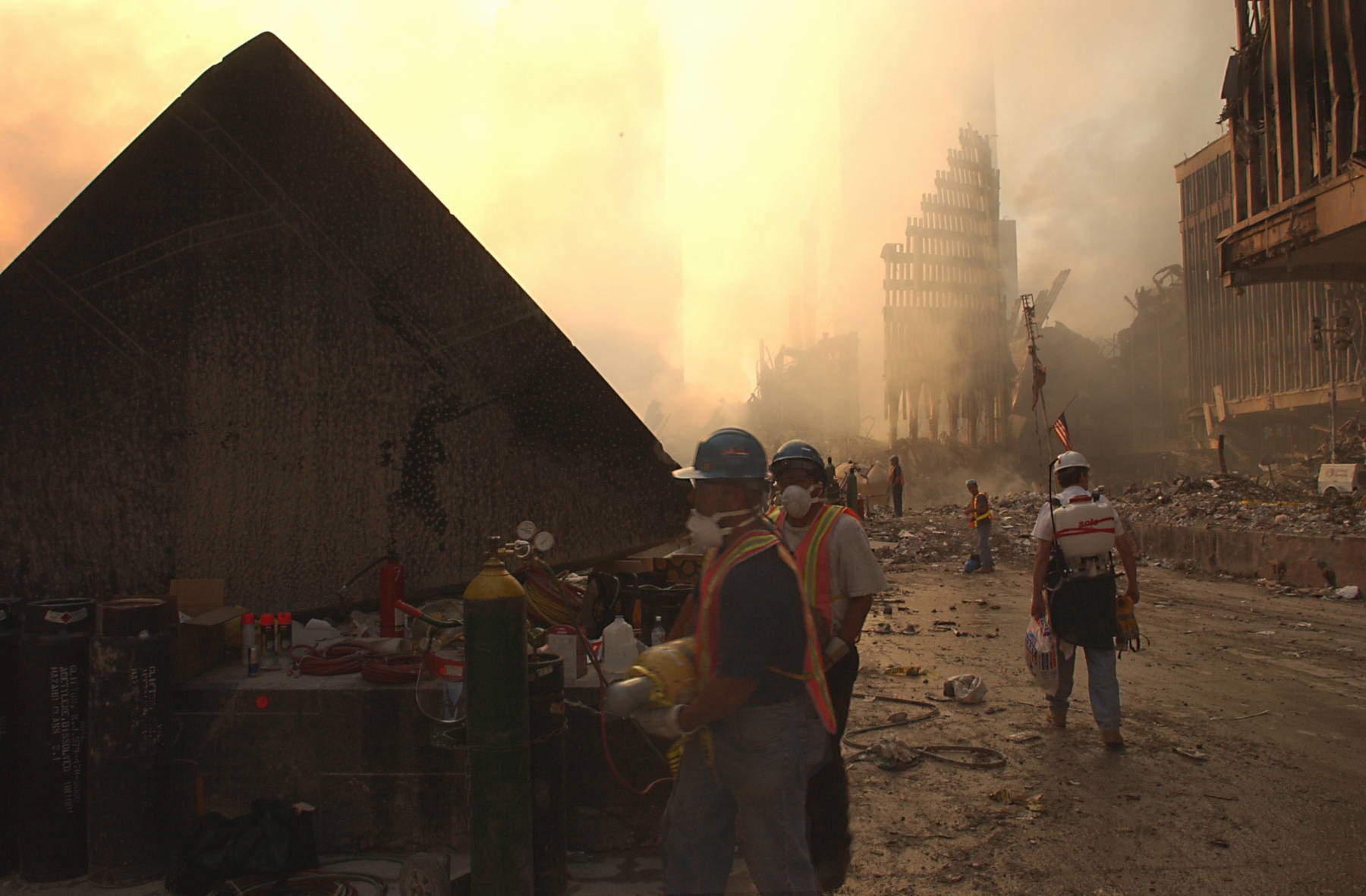
Sky Gate, New York was a sculpture by Louise Nevelson (Kyiv, 1899 - New York, 1988) placed in the mezzanine of the World Trade Center’s North Tower and like other World Trade Center works, did not survive 9/11 and was not recovered from the debris. Made between 1977 and 1978, the work remained in place until the collapse of the Twin Towers during the September 11, 2001 attacks, when it was completely destroyed. Nevelson’s inspiration came from a view of the New York skyline observed during a flight to Washington; the artist conceived the work as an abstract representation of the city’s windows through darkly painted wooden reliefs.
Commissioned by Saul Wenegrat, director of the Port Authority’s art program and promoter of the Percent for Art initiative, the work underwent several revisions before its final installation. At more than 9 meters wide and 5 meters high, composed of more than 35 segments, Sky Gate represented Nevelson’s largest work to date. It was naugurated on December 12, 1978 in the presence of Kitty Carlisle Hart and dominated the view of the Austin J. Tobin Plaza.
The Memorial Dedicated to the 1993 World Trade Center Massacre remembers the six victims of the February 26 bombing in downtown New York City. The Port Authority of New York & New Jersey Art Commission entrusted its creation to artist Elyn Zimmerman (Philadelphia, 1945), who completed the work in 1995. The memorial was placed in the underground parking lot of the World Trade Center, between the Twin Towers, in Austin J. Tobin Plaza, exactly above the site of the explosion and, like many other installations in the complex, disappeared during the attacks of September 11, 2001.
Zimmerman conceived the memorial so that it could be perceived from above as a target, emphasizing the precise location of the tragic event. The white granite walls featured intentional cracks, inspired by ancient burial mounds and symbolic mapping of collective burials. In the center, a fountain integrated the sense of loss and memory into the urban space, transforming the area into a place of reflection. After its destruction in 2001, few elements survived. Among the fragments, there remained a piece of granite engraved with the name “John D,” in memory of John DiGiovanni. The fragment is now preserved at the National September 11 Memorial & Museum, a testament to both the 1993 tragedy and the subsequent devastation of the World Trade Center.
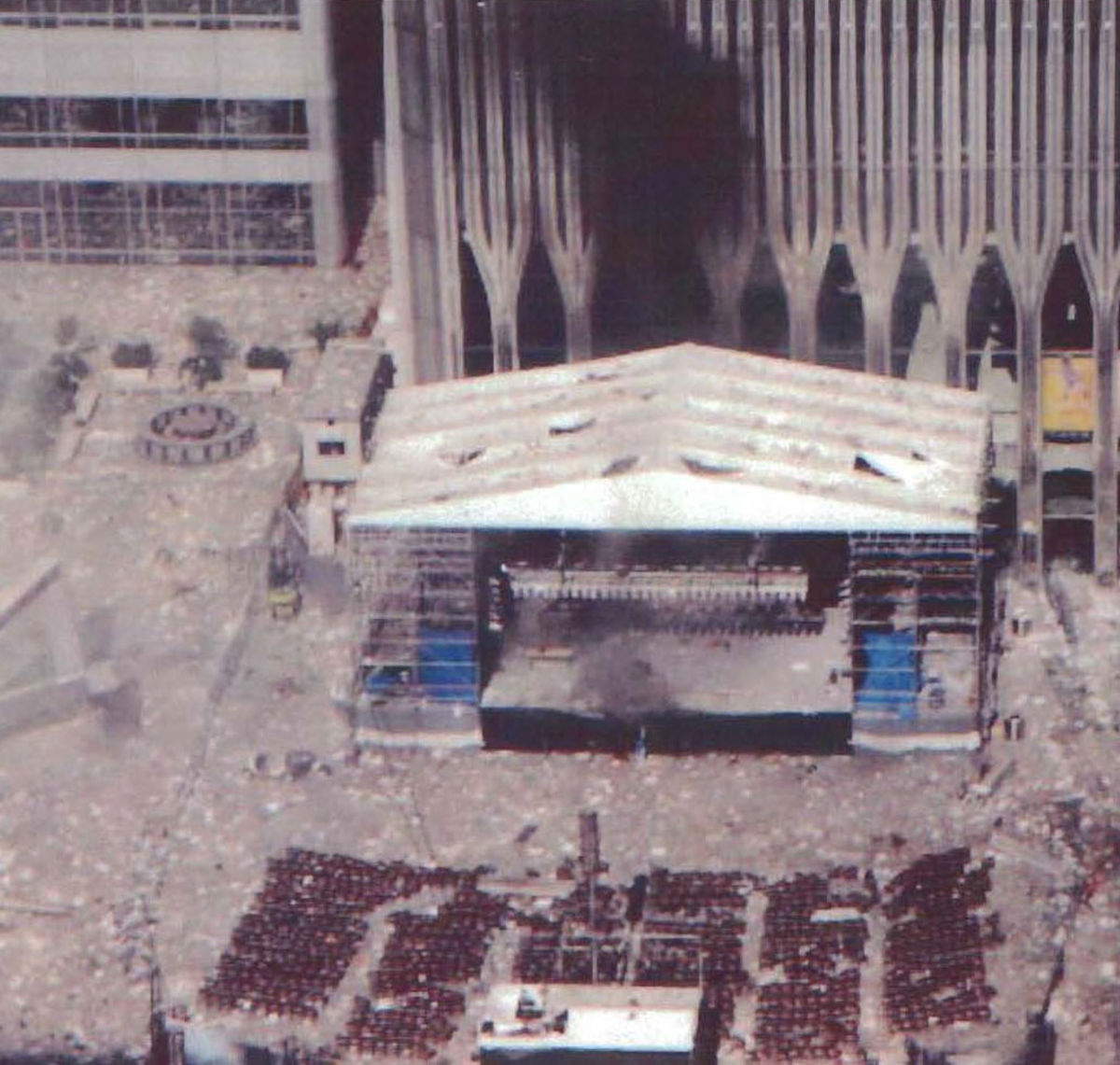
Warning: the translation into English of the original Italian article was created using automatic tools. We undertake to review all articles, but we do not guarantee the total absence of inaccuracies in the translation due to the program. You can find the original by clicking on the ITA button. If you find any mistake,please contact us.